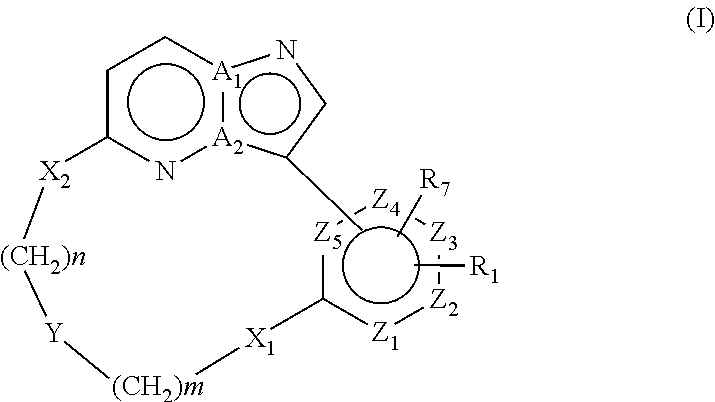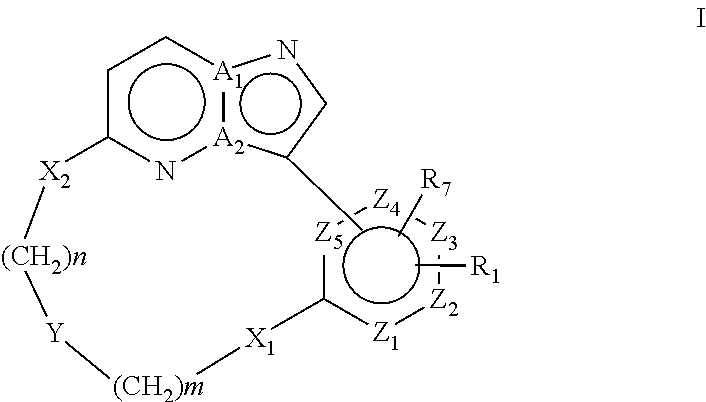Macrocyclic FLT3 kinase inhibitors
a kinase inhibitor and macrocyclic technology, applied in the field of macrocyclic compounds, can solve the problems of decreased remission time and disease free survival, poor prognosis of patients with flt3 mutations, and no compound disclosed in said references has been shown to inhibit flt3 activity, so as to achieve the effect of inhibiting the activity of a kinas
- Summary
- Abstract
- Description
- Claims
- Application Information
AI Technical Summary
Problems solved by technology
Method used
Image
Examples
example 1
[0724]Example 1 is prepared following general scheme 1.
Preparation of Intermediate 1
[0725]
[0726]A mixture of 3-bromo-5-chloro-pyrazolo[1,5-a]pyrimidine (5.00 g, 21.51 mmol), 2-(2-aminoethoxy)ethanol (2.37 ml, 23.66 mmol) and N,N-diisopropylethylamine (4.50 ml, 25.81 mmol) in acetonitrile (65 ml) was refluxed overnight. The reaction mixture was cooled and the solvent was removed under reduced pressure. The residue was dissolved in ethyl acetate and washed with water and brine. The organic layer was dried, filtered and the solvent was removed under reduced pressure. The residue was purified by flash column chromatography over silica gel using heptane and ethyl acetate as eluents. The product fractions were collected and the solvent was evaporated.
[0727]LCMS method 1: MH+=301, RT=0.586 min
Preparation of Intermediate 2
[0728]
[0729]Tert-butyldimethylsilyl chloride (4.86 g, 32.27 mmol) was added to a suspension of intermediate 1 (21.51 mmol) and triethylamine (5.96 ml, 43.02 mmol) in N,N-d...
preparation of example 1
[0756]
[0757]Intermediate 9 (1.75 g, 3.85 mmol) and lithium hydroxide monohydrate (12.00 g, 11.55 mmol) were suspended in tetrahydrofuran / methanol (1:1, 12 ml). The mixture was stirred overnight at 50° C. The reaction mixture was cooled and 1N hydrochloric acid in water was added to obtain pH 3. The solvent was removed under reduced pressure and purified by flash chromatography on silica gel using dichloromethane and methanol as eluents. The product fractions were collected and the solvent was evaporated. The obtained solid was triturated in methanol to yield the desired product.
[0758]Yield: 705 mg of example 1 (54%)
[0759]LCMS method 1: MH+=341, RT=0.696 min
example 2
[0760]Example 2 is prepared following general scheme 1.
Preparation of Intermediate 10
[0761]
[0762]A mixture of 1,4-dioxane and water (3:1, 40 ml) was degassed by bubbling nitrogen gas through the mixture. Intermediate 3 (1.85 g, 3.59 mmol), (3-aminophenyl)boronic acid (0.72 g, 4.67 mmol), tetrakis(triphenylphosphine)palladium(0) (46 mg, 0.04 mmol), 2-dicyclohexylphosphino-2′,4′,6′-triisopropylbiphenyl (Xphos) (67 mg, 0.14 mmol) and potassium phosphate tribasic (5 eq.) were added and the mixture was stirred under nitrogen gas at 80° C. for 2 hours. The reaction mixture was cooled, diluted with ethyl acetate and the organic layer was washed with brine. The organic layer was dried, filtered and the solvent was removed under reduced pressure. The residue was purified by flash column chromatography over silica gel using heptane and ethyl acetate as eluents. The product fractions were collected and the solvent was evaporated.
[0763]Yield: 1.64 g of intermediate 10 (87%)
[0764]LCMS method 1: ...
PUM
| Property | Measurement | Unit |
|---|---|---|
| particle size | aaaaa | aaaaa |
| weight | aaaaa | aaaaa |
| weight | aaaaa | aaaaa |
Abstract
Description
Claims
Application Information
 Login to View More
Login to View More - R&D Engineer
- R&D Manager
- IP Professional
- Industry Leading Data Capabilities
- Powerful AI technology
- Patent DNA Extraction
Browse by: Latest US Patents, China's latest patents, Technical Efficacy Thesaurus, Application Domain, Technology Topic, Popular Technical Reports.
© 2024 PatSnap. All rights reserved.Legal|Privacy policy|Modern Slavery Act Transparency Statement|Sitemap|About US| Contact US: help@patsnap.com










